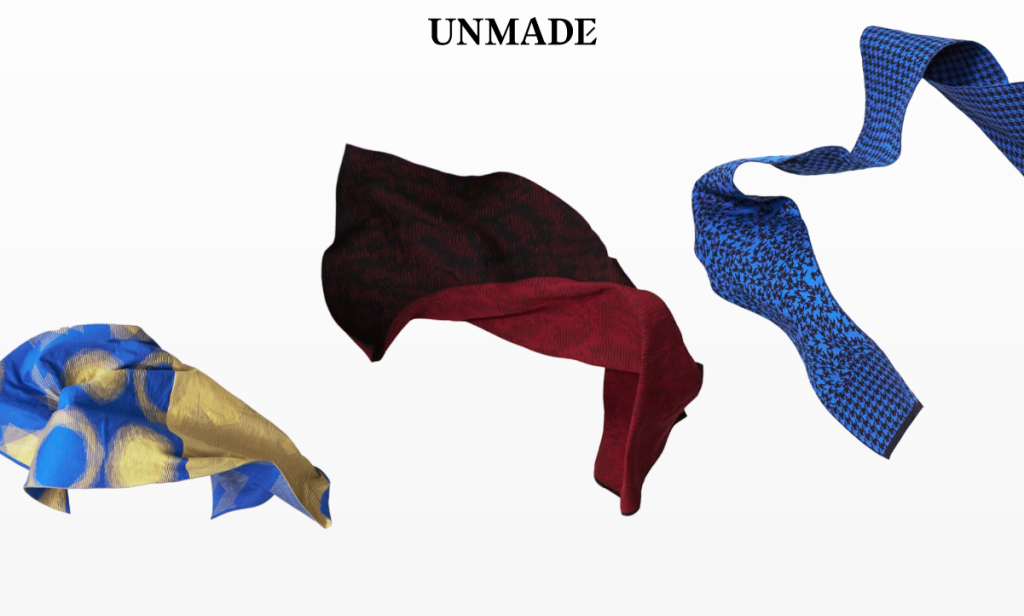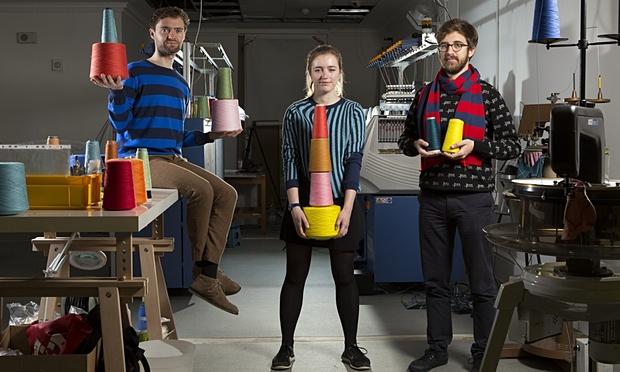The images conjured up in the minds of most people when they think about knitting involve little old ladies in rocking chairs working on afghans or bulky sweaters while chatting amiably. The world of commercially produced knitwear, however, is one that relies on the latest in technology.
 There are only three ways of turning fibers into the cloth used in commercial clothing production: weaving, felting, and knitting. If you own anything with ‘stretch’ in it, it has most likely been produced by knitting. While an individual knitting uses two pointed needles to create cloth from yarn, larger scale knit production doesn’t just require that you crowd more of these knitting wizards into a room. Instead, knitting can be done on a knitting machine which uses dozens of needles at the same time to build up the garment, line by line.
There are only three ways of turning fibers into the cloth used in commercial clothing production: weaving, felting, and knitting. If you own anything with ‘stretch’ in it, it has most likely been produced by knitting. While an individual knitting uses two pointed needles to create cloth from yarn, larger scale knit production doesn’t just require that you crowd more of these knitting wizards into a room. Instead, knitting can be done on a knitting machine which uses dozens of needles at the same time to build up the garment, line by line.
It was only a matter of time before somebody started thinking about the similarities in process, product, and potential between knitting and 3D printing. Ben Alun-Jones, one of the founders of a company called Unmade, was interested in the possibilities for coding to be used in the creation of knitwear, just as it is used in 3D printing, in order to create made to order, custom garments.
 This isn’t just important because of the potential for people to have greater access to clothes they want that are made for their bodies, but also because about 10% of all clothing produced simply goes into a landfill without having ever found an owner. By utilizing the same type of create to order system that has become the norm with 3D printing, Unmade can ensure that the garments being produced are what is needed.
This isn’t just important because of the potential for people to have greater access to clothes they want that are made for their bodies, but also because about 10% of all clothing produced simply goes into a landfill without having ever found an owner. By utilizing the same type of create to order system that has become the norm with 3D printing, Unmade can ensure that the garments being produced are what is needed.
Alun-Jones explained what is unique about using this approach toward programming their knitting machines:
“They can be used to make something that is useful rather than making just anything. You press a button and a garment comes out…We seem to have lost something in mass production where you are making things for everyone, but everything is made for no one.”
It is not just the idea of programming the machines to make only what is needed that makes it similar to 3D printing production. The lessons from additive manufacturing are also being learned in terms of client involvement in the process of creation. This could range from simple mass customization, finding a garment you liked and then inputting information on things such as sleeve length and waist size, all the way to the ability to upload a completely unique design that can be sent off to the knitting machine for production.

The founders of Unmade: Ben Alun-Jones, Kirsty Emery, and Hal Watts [Photo: Richard Saker for the Observer]
“Knitting is the future of textiles. All the things people dream of doing with 3D printers is one of the oldest things going. We are building a completely new experience for the customer where you can be part of the creation process. We have made our own file format that is like an MP3 is to music– we have created a .KNIT which is a file format for knitting…Ultimately, we are trying to create the highest personalized garment you can have. Imagine a place were a more appropriate, better use of resources makes things that people want and are involved in. You want to own it and it’s something to be proud of. Knitting is amazing.”
I couldn’t agree more. Let us know your thoughts in the Unmade forum thread on 3DPB.com.
Subscribe to Our Email Newsletter
Stay up-to-date on all the latest news from the 3D printing industry and receive information and offers from third party vendors.
You May Also Like
Gorilla Sports GE’s First 3D Printed Titanium Cast
How do you help a gorilla with a broken arm? Sounds like the start of a bad joke a zookeeper might tell, but it’s an actual dilemma recently faced by...
Nylon 3D Printed Parts Made More Functional with Coatings & Colors
Parts 3D printed from polyamide (PA, Nylon) 12 using powder bed fusion (PBF) are a mainstay in the additive manufacturing (AM) industry. While post-finishing processes have improved the porosity of...
$25M to Back Sintavia’s Largest Expansion of Metal 3D Printing Capacity Since 2019
Sintavia, the digital manufacturing company specializing in mission-critical parts for strategic sectors, announced a $25 million investment to increase its production capacity, the largest expansion to its operations since 2019....
Velo3D Initiates Public Offering in a Bid to Strengthen Financial Foundations and Drive Future Growth
Velo3D (NYSE: VLD) has been among a number of publicly traded 3D printing firms that have attempted to weather the current macroeconomic climate. After posting a challenging financial report for 2023,...































